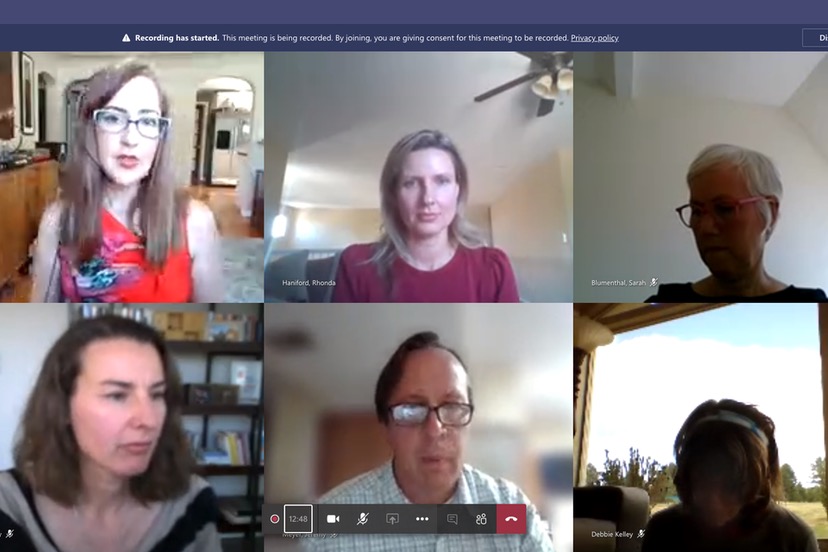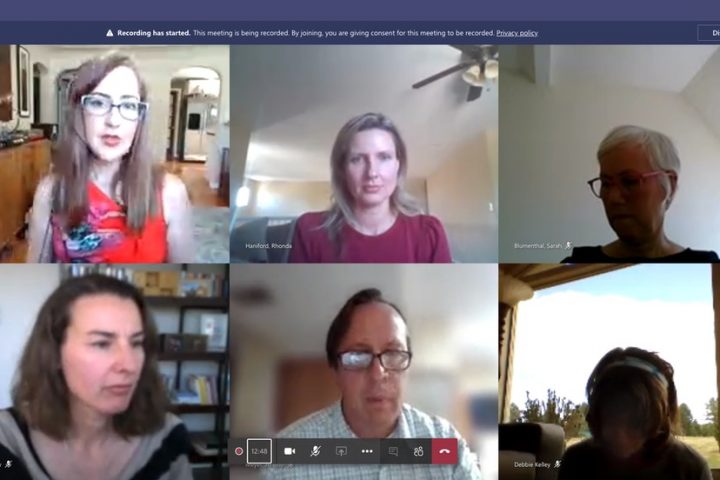The Colorado Department of Education (CDE) recognizes that this information may be overwhelming as you consider how to approach the 2020-21 school year…
— from the Colorado Department of Education “Framework and Toolkit for School and District Leaders for Feedback”
This past Tuesday, May 26, members of the news media were invited to listen to a Zoom presentation by the Colorado Department of Education (CDE), featuring Colorado Education Commissioner Katy Anthes, Associate Commissioner Rhonda Haniford, Colorado State School Nurse Consultant Sarah Blumenthal, and Therese Pilonetti, manager of the Colorado Department of Public Health & Environment’s Institutions and Emerging Programs Unit. The presenters also fielded questions from the audience. The question were many and varied.
The presentation concerned some tentative new ‘guidance’ being developed for Colorado K-12 schools — the institutions of learning that incidentally allow both parents in a family to hold down full-time jobs, if they are lucky enough (or unlucky enough) to have jobs during this season of confusion.
The ‘guidance’ has now been published on the CDE website as Framework and Toolkit for School and District Leaders for Feedback. The multi-faceted toolkit prominently warns us, at the top of each page, that it’s a “DRAFT” and that “The guidance in the toolkit will be adjusted over the coming weeks based on feedback and the evolving situation with COVID-19.”
The Toolkit is clearly a work in progress. The website includes “Provide Feedback” buttons in the right-hand column (or on your phone, at the bottom of each page) that allow school and district leaders to weigh in with ideas, or to ask questions.
My goodness. So many questions…
The sections include:
- Health and Safety
- Continuity of Learning
- Conditions for Learning
- Planning and Communication
- Policy and Funding
- Additional Resources and Tools
- Acknowledgements
- Advisory Committee
The draft “Health & Safety” section, for example, begins like this:
Should you consider opening?
- Will reopening be consistent with applicable state and local orders?
- Is the school ready to protect children and employees at higher risk for severe illness?
- Are you able to screen students and employees upon arrival for symptoms and history of exposure?

Are recommended health and safety actions in place?
- Promote healthy hygiene practices such as hand washing and employees wearing a cloth face covering, as feasible
- Intensify cleaning, disinfection, and ventilation
- Encourage social distancing through increased spacing, small groups and limited mixing between groups, if feasible.
- Train all employees on health and safety protocols

Is ongoing monitoring in place?
- Develop and implement procedures to check for signs and symptoms of students and employees daily upon arrival, as feasible
- Encourage anyone who is sick to stay home
- Plan for if students or employees get sick
- Regularly communicate and monitor developments with local authorities, employees, and families regarding cases, exposures, and updates to policies and procedures
- Monitor student and employee absences and have flexible leave policies and practices
- Be ready to consult with the local health authorities if there are cases in the facility or an increase in cases in the local area

The wording on this page is borrowed, word for word, from a summary document of Centers for Disease Control (CDC) guidance, and the links included take you directly to the CDC website. But this page is only one part of the ‘Health & Safety’ section, which is, in turn, only one part of the more extensive 47-page Toolkit.
We notice, above, the first sentence of the ‘Health & Safety’ section:
Will reopening be consistent with applicable state and local orders?
Maybe that’s a trick question? The state and local orders are changing by the week, and are likely to continue changing for the next several months, especially if the state starts to see fresh COVID-19 outbreaks taking place. Currently, the Colorado orders make it difficult to imagine classrooms open for anything approaching normal education. A Colorado classroom typically houses 20-40 students in a room, and in middle schools and high schools, the students move from classroom to classroom, which would make contact tracing of an potential outbreak difficult, if not impossible.
Will schools open with fewer than half the students attending, so that rooms can be limited to 9 students plus one teacher? Will students attend on some kind of rotation, perhaps for only one or two days per week? Will students be required to remain in a single room, while teachers move between classrooms?
How will lunches be served?
Will students who doing poorly be given priority for face-to-face instruction? How much ‘distance learning’ will continue to happen via the Internet? How will schools deliver and monitor the distance learning results, if the teachers are working all day in a classroom with select students?
One piece of draft guidance, I found interesting.
Consider allowing teachers’ children to come to school everyday to support staff returning to work.
This makes sense, from a certain perspective. How can a teacher possibly do their job if they need to stay home, caring for their own children?
But what about every other parent who has a job to attend to? The simple fact is, public school is not merely a place where kids learn to read and write and work arithmetic problems. Public schooling is also a vast (and rather expensive) babysitting service, upon which almost every working family heavily depends, at some point in the family’s history.
To tell the local nurse that her child needs to do ‘distance learning’ at home, so that the teacher’s child can attend school every day… ?
Listening to the May 26 presentation by CDE, it was very clear to me that no one understands how public schools will function come September, and that — judging by current “social distancing” orders and policies — many of the problems appear almost insurmountable. We have built a system that depends on cramming as many children as possible into enclosed spaces — classrooms, cafeterias, school buses, hallways, gymnasiums, restrooms — and most of our schools have outdated and inadequate ventilation systems. Most schools have no full-time nurse on staff. Some schools have no place to quarantine a student who is showing symptoms.
We have thousands of schools that are quite frankly unsuited to the current situation. How to reconcile the shortcomings?


